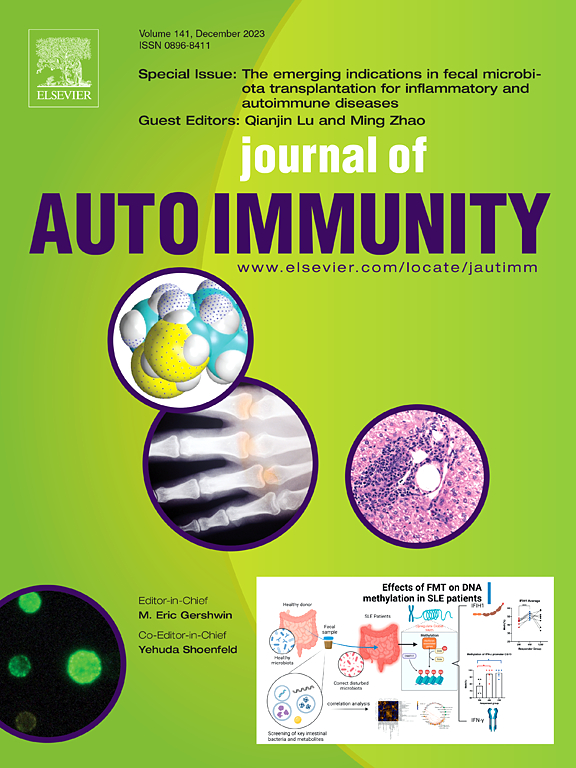LAMP3-mediated epithelial-mesenchymal transition promotes the invasion and excessive proliferation of fibroblast-like synoviocytes in rheumatoid arthritis
IF 7
1区 医学
Q1 IMMUNOLOGY
引用次数: 0
Abstract
Objective
The aim of this study was to explore the functional role of LAMP3-mediated epithelial-mesenchymal transition (EMT) in fibroblast-like synoviocytes (FLSs) in rheumatoid arthritis (RA) patients and to evaluate its potential as a therapeutic target.
Methodology
Changes in EMT and LAMP3 were investigated in the synovial tissue and FLSs of RA patients. In vitro experiments were performed using the EMT inhibitor C19, siRNA, and lentivirus to examine the impact of EMT and LAMP3 on RA-FLSs and the underlying mechanisms involved. Finally, C19 was administered to mice with collagen-induced arthritis (CIA) to validate the therapeutic efficacy of C19 in treating arthritis.
Results
Compared with patients with osteoarthritis (OA), RA patients exhibited increased EMT and increased expression of LAMP3 in the synovium. The results from the in vitro experiments demonstrated that inhibiting EMT effectively reduced the excessive proliferation, anti-senescent properties, migration, and invasive behavior of RA-FLSs, as well as the secretion of MMP1, MMP3, and MMP13. Additionally, regulating the expression of LAMP3 not only affected the EMT pathway but also impacted the excessive proliferation and invasive behavior of RA-FLSs. In the CIA model, administration of the EMT inhibitor C19 significantly alleviated the progression of arthritis.
Conclusion
These findings demonstrate the inhibitory impact of EMT on arthritis and suggest that inhibiting EMT or LAMP3 may be a promising novel therapeutic approach for treating RA.

lamp3介导的上皮-间质转化促进类风湿关节炎中成纤维细胞样滑膜细胞的侵袭和过度增殖。
目的:本研究旨在探讨lamp3介导的上皮-间充质转化(EMT)在类风湿关节炎(RA)患者成纤维细胞样滑膜细胞(FLSs)中的功能作用,并评估其作为治疗靶点的潜力。方法:研究RA患者滑膜组织和FLSs中EMT和LAMP3的变化。利用EMT抑制剂C19、siRNA和慢病毒进行体外实验,研究EMT和LAMP3对RA-FLSs的影响及其潜在机制。最后,将C19用于胶原诱导关节炎(CIA)小鼠,验证C19对关节炎的治疗效果。结果:与骨关节炎(OA)患者相比,RA患者EMT增高,滑膜LAMP3表达增高。体外实验结果表明,抑制EMT可有效降低RA-FLSs的过度增殖、抗衰老特性、迁移和侵袭行为,以及MMP1、MMP3和MMP13的分泌。此外,调节LAMP3的表达不仅会影响EMT通路,还会影响RA-FLSs的过度增殖和侵袭行为。在CIA模型中,给药EMT抑制剂C19可显著缓解关节炎的进展。结论:这些发现证明了EMT对关节炎的抑制作用,并提示抑制EMT或LAMP3可能是治疗RA的一种有希望的新方法。
本文章由计算机程序翻译,如有差异,请以英文原文为准。
求助全文
约1分钟内获得全文
求助全文
来源期刊

Journal of autoimmunity
医学-免疫学
CiteScore
27.90
自引率
1.60%
发文量
117
审稿时长
17 days
期刊介绍:
The Journal of Autoimmunity serves as the primary publication for research on various facets of autoimmunity. These include topics such as the mechanism of self-recognition, regulation of autoimmune responses, experimental autoimmune diseases, diagnostic tests for autoantibodies, as well as the epidemiology, pathophysiology, and treatment of autoimmune diseases. While the journal covers a wide range of subjects, it emphasizes papers exploring the genetic, molecular biology, and cellular aspects of the field.
The Journal of Translational Autoimmunity, on the other hand, is a subsidiary journal of the Journal of Autoimmunity. It focuses specifically on translating scientific discoveries in autoimmunity into clinical applications and practical solutions. By highlighting research that bridges the gap between basic science and clinical practice, the Journal of Translational Autoimmunity aims to advance the understanding and treatment of autoimmune diseases.
 求助内容:
求助内容: 应助结果提醒方式:
应助结果提醒方式:


